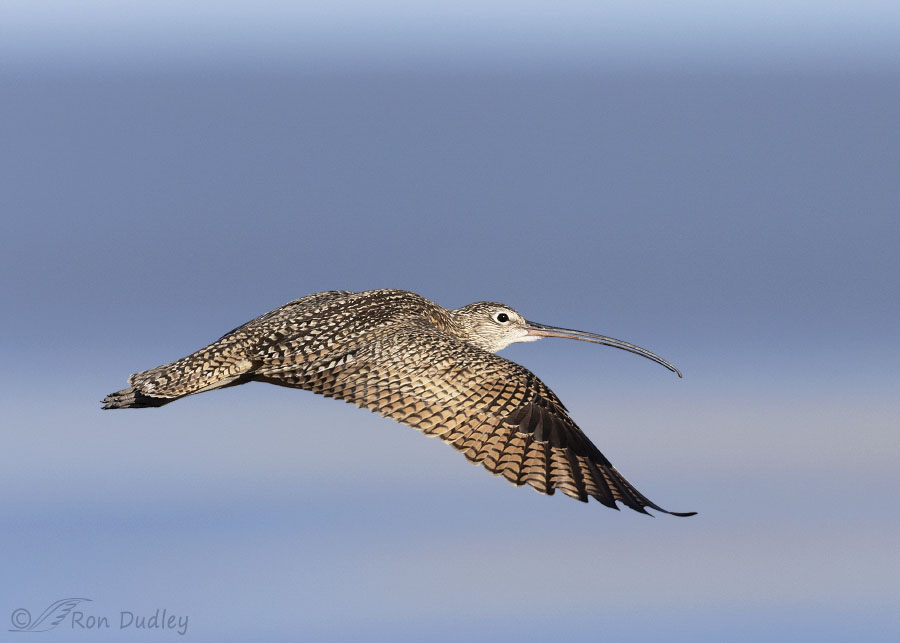A combination of flight posture and background that I really like.
Six days ago I posted a couple of photos of this male Long-billed Curlew on Antelope Island, saying that I managed to get about a half dozen photos of him in flight even though I was actually driving about 10 mph on the deserted road when I took them. I should have looked at them more carefully before I chose which ones to post because there’s another one I like even more, partly because the curlew’s flight posture is one I seldom get from any species.
So I chose to post it today as a standalone.

1/5000, f/6.3, ISO 640, Canon R5, Canon EF500mm f/4L IS II USM + 1.4 tc, not baited, set up or called in
When birds are attempting to increase their flight speed they often assume this “wings swept forward” posture in an attempt to scoop more air prior to completing the back/down stroke. But in my experience, especially with raptors, the wing usually hides all or part of their head so I seldom get photos of this posture that I like. This photo is an exception.
His flight posture, combined with the beautiful blues and horizontal banding of the Great Salt Lake in the background, make the photo stand out for me. The curlew’s head, bill and eye are visible, he’s sharp, I have light in his eye and his unusually long bill only adds to all of the other horizontal elements in the image, an effect that I like.
Throw in the fact that this shot, and the others I got, were grab shots taken while my pickup was still moving and you have ample evidence as to why the photo stands out for me. Shots like this don’t come along every day.
Not with me they don’t.
Ron


I don’t think I have ever seen a “grab” shot that good. Well done. Love the detail.
Outstanding!
Thanks, Gary.
Wowsers. WHAT a capture. Aerodynamics on beautiful display…
Thanks, EC.
Beautiful.
Thanks, April. I hope you’re feeling much better today.
Perfect shot. Most people tend to think of a bird’s wing motion as just up and down. But simply moving up and down accomplishes almost nothing. On the “downstroke” the wing moves forward and down. In the forward motion, the airfoil shape of the wing creates lift, not the downward motion. This shows so well where that portion of the wingbeat causes lift. And being able to see the bird’s head at that time is a nice bonus.
Dan, I think the flight of ravens exaggerates the wing motions you describe so they’re more easily observed. To me it often looks like ravens are “rowing” themselves through the air.
Here’s what I like about this shot. From the neck on back the shape of the bird is pure biomorphic aerodynamics, contrasted with that utilitarian design of the mud probe out front. I enjoy the same contrast with the way pelicans are put together. So purpose built. This shot really captures that.
Well said (described), Michael. Thank you.
For me this evokes the feeling of gliding effortlessly through the air. I often look up at hawks and envy what they must see and feel. That must be why people don parachutes and jump out of perfectly good airplanes!
Linda, I’ve always wanted to be able to fly (or glide) but it would take more of a reward than that to get me to jump out of an airplane, parachute or not.
Your “grab shots” are amazing, Ron! I’d also add the beautiful color patterns on the curlew’s dorsal surfaces as part of the appeal of this shot.
I’m imagining my trying to get a similar shot and ending up with images of the ground, the sky, or the side of the car — all out of focus and possibly with my thumb in the shot somehow. 😂
“ending up with images of the ground, the sky, or the side of the car — all out of focus and possibly with my thumb in the shot”
Believe me, I’ve done them all Marty. My thumb in the photo is a specialty of mine with cell phone photos.
I’m so glad I’m not alone!
Snap Marty. Most definitely. And my thumb would be the only bit that was in focus. Or recognisable.
😂💕
You have captured the graceful contour of the outstretched wing so well, as you do with so many other birds. The primary coverts,
mostly hidden when the Curlew is at rest, are on full display with a peek of the alula just above. The bill and wing vie to see which leads, with the wing winning by a feather.
Not bad for a grab. Quite the opposite.
“The bill and wing vie to see which leads, with the wing winning by a feather”
I like the way you said that, Lyle. Perhaps you should consider a second career as a horse race announcer.
Beautiful! Love the detail even showing the upper beak being longer than the lower and the solid brown of some of the feathers….. 🙂 It was “your day” when it came to the Curlew!
Yup, it was “my day”, or at least my few moments with the curlew. Thanks, Judy.